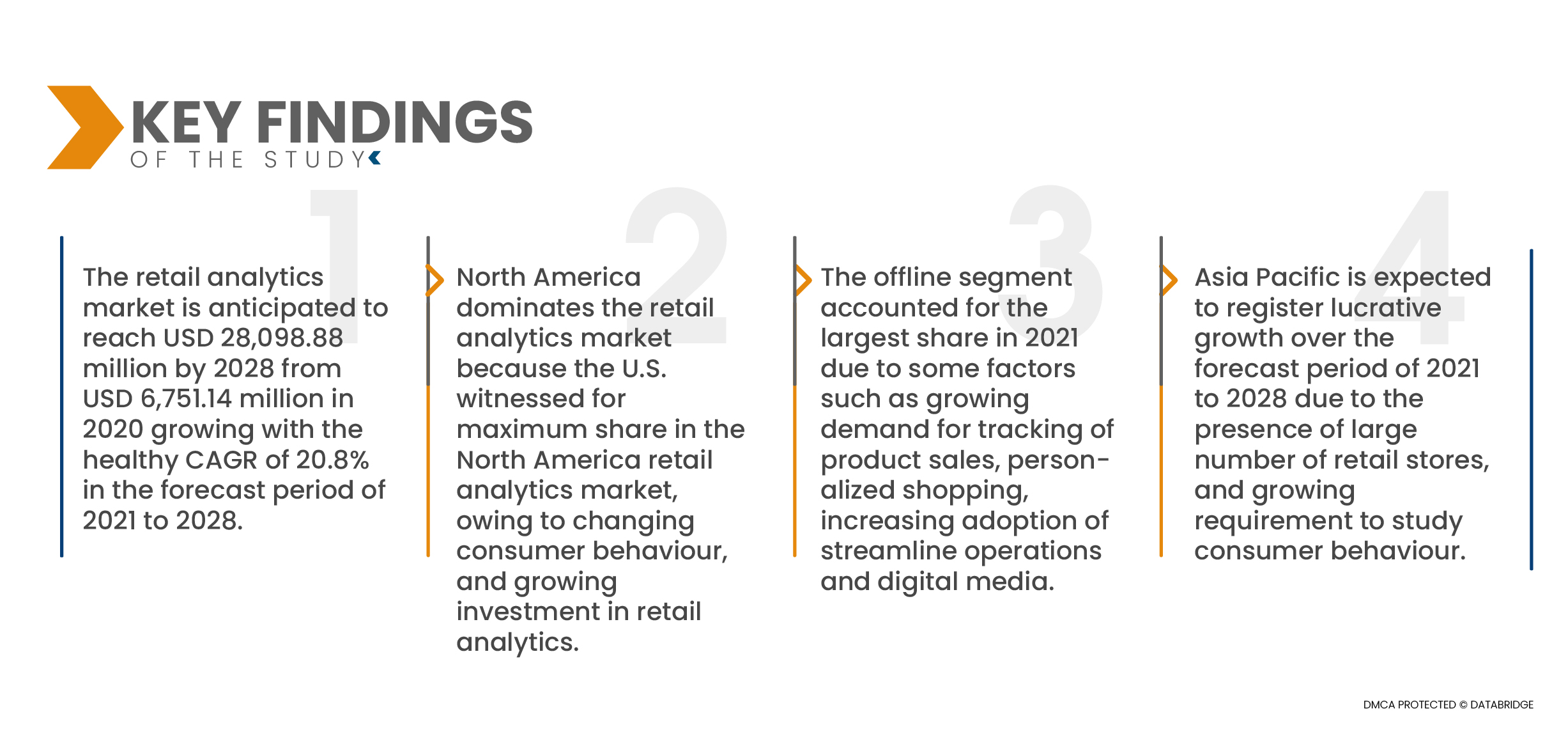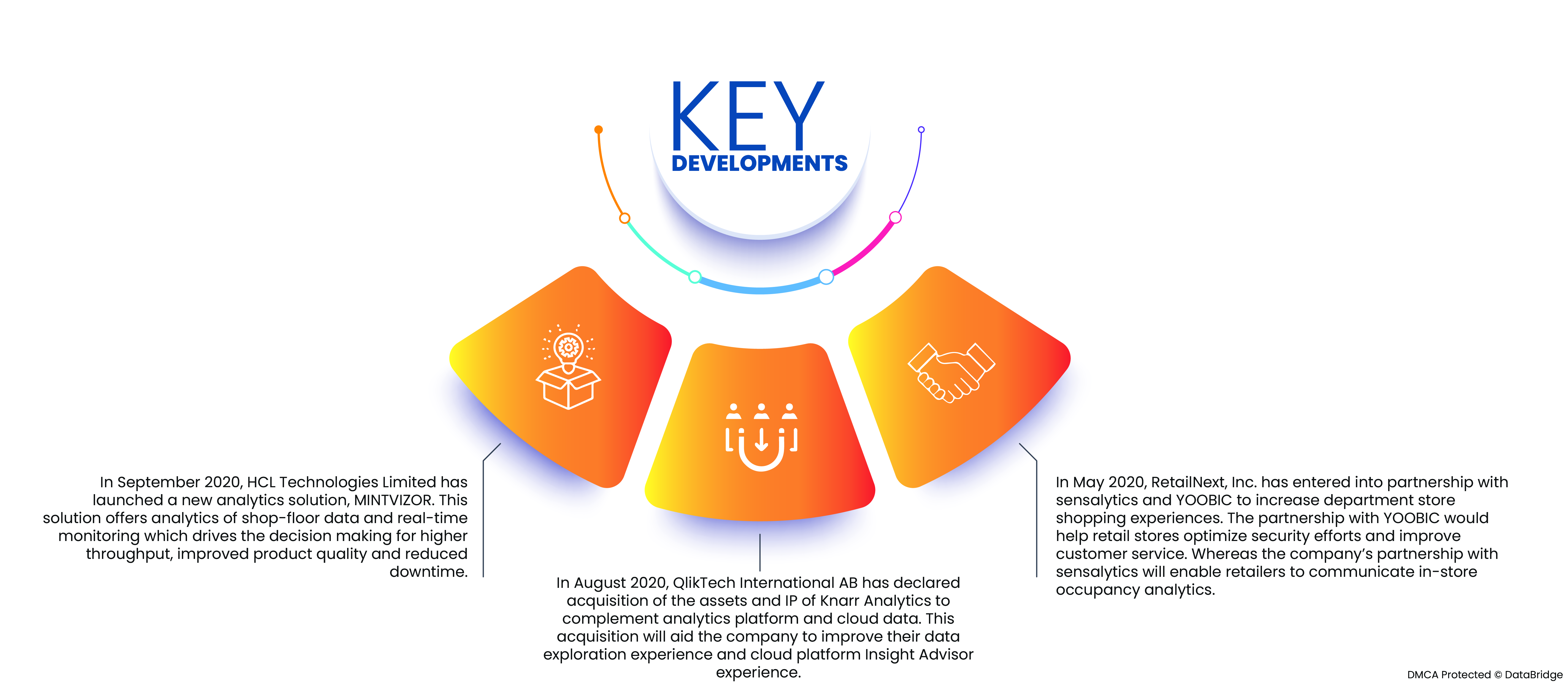오늘날 소매업체들은 비즈니스 프로세스를 중앙 집중화하고 디지털화하는 데 주력하고 있습니다. 디지털화는 여러 데이터 처리 도구, 소프트웨어 및 장치를 통해 물리적 데이터를 디지털 정보로 변환하는 과정입니다. 따라서 중앙 집중화와 디지털화는 소매 산업 전체에 영향을 미치며 새롭고 향상된 비즈니스 모델을 가능하게 합니다. 소매업체들은 디지털로 진화하는 시장에서 살아남아 고객에게 더 나은 경험을 제공하기 위해 서비스를 중앙 집중화하고 디지털화해야 하며, 이는 향후 시장 성장의 주요 요인이 될 것입니다.
전체 보고서는 https://www.databridgemarketresearch.com/reports/global-retail-analytics-market 에서 확인하세요.
데이터 브릿지 마켓 리서치(Data Bridge Market Research)에 따르면, 소매 분석 시장은 2020년 67억 5,114만 달러에서 2028년 280억 9,888만 달러로 성장할 것으로 예상되며, 2021년부터 2028년까지 20.8%의 안정적인 연평균 성장률(CAGR)을 기록할 것으로 전망됩니다. 머신러닝(ML), 증강현실(AR), 인공지능(AI)과 같은 기술은 소매업체에 향상된 고객 경험을 통해 매출을 창출할 수 있는 데이터 통찰력을 제공하기 때문에 부상하고 있습니다. 이는 예측 기간 동안 소매 분석 시장 성장에 잠재적 기회를 제공할 것으로 예상되는 주요 기술 중 하나입니다.

사물인터넷(IOT) 사용 증가로 시장 성장률이 높아질 것으로 예상 됩니다.
소매 프로세스에서 사물 인터넷(IoT) 활용 증가는 소매업의 효율성과 생산성을 향상시키고 소매 분석 도구에 대한 수요를 창출합니다. 사물 인터넷(IoT)은 효율적이고 신속한 물류, 재고 관리, 매장 내 구매자 행동 추적 및 공급망 관리, 스마트 창고 등을 의미합니다. 사물 인터넷(IoT)은 소매업체가 고객 및 기업과 연결될 수 있도록 해주었습니다. 오늘날 고객에게 사물 인터넷은 매우 중요한 의미를 지닙니다. 이러한 연결 기술은 보편화될 잠재력을 가지고 있기 때문입니다. 이러한 기술은 데이터 처리 생산성을 높이고 수동 오류를 최소화하여 소매 분석 성장을 촉진합니다.
보고서 범위 및 시장 세분화
보고서 메트릭
|
세부
|
예측 기간
|
2021년부터 2028년까지
|
기준 연도
|
2020
|
역사적인 해
|
2019 (2013~2018년으로 맞춤 설정 가능)
|
양적 단위
|
매출(백만 달러), 볼륨(단위), 가격(달러)
|
다루는 세그먼트
|
제공(소프트웨어 및 서비스), 배포 모델(클라우드 및 온프레미스), 조직 규모(대기업 및 중소기업(SMES)), 비즈니스 기능(영업 및 마케팅, 공급망, 재무, 운영, 조달, 인적 자원), 애플리케이션(고객 관리, 상품 분석, 재고 분석, 성과 분석, 가격 분석, 수익 분석, 주문 및 이행 관리, 클러스터 계획 및 운송 관리 등), 최종 사용자(오프라인 및 온라인(전자 상거래)),
|
포함 국가
|
미국, 캐나다 및 멕시코(북미), 독일, 프랑스, 영국, 네덜란드, 스위스, 벨기에, 러시아, 이탈리아, 스페인, 터키, 유럽의 기타 유럽 국가, 중국, 일본, 인도, 한국, 싱가포르, 말레이시아, 호주, 태국, 인도네시아, 필리핀, 아시아 태평양(APAC)의 기타 아시아 태평양 국가(APAC), 사우디 아라비아, UAE, 이스라엘, 이집트, 남아프리카 공화국, 중동 및 아프리카(MEA)의 일부인 기타 중동 및 아프리카(MEA), 브라질, 아르헨티나 및 남미의 일부인 기타 남미
|
시장 참여자 포함
|
IBM(미국), Oracle(미국), Microsoft(미국), HCL Technologies Limited(인도), Salesforce, Inc.(미국), SAP SE(독일), Wipro Limited(인도), SAS Institute Inc.(미국), QlikTech International AB(영국), Teradata(미국), Retail Solutions, Inc.(미국), TABLEAU SOFTWARE, LLC(미국), 1010data, Inc.(미국), TIBCO Software Inc.(미국), Happiest Minds(인도), Adobe(미국), FLIR Systems, Inc.(미국), MICROSTRATEGY INCORPORATED(미국), RetailNext, Inc.(미국), Fractal Analytics Inc.(미국), ALTERYX, INC(미국) 등이 있습니다.
|
보고서에서 다루는 데이터 포인트
|
Data Bridge Market Research 팀이 큐레이팅한 시장 보고서에는 시장 가치, 성장률, 시장 부문, 지리적 범위, 시장 참여자, 시장 시나리오와 같은 시장 통찰력 외에도 심층적인 전문가 분석, 수입/수출 분석, 가격 분석, 생산 소비 분석, 유봉 분석이 포함되어 있습니다.
|
세그먼트 분석:
소매 분석 시장은 제공 서비스, 배포 모델, 조직 규모, 비즈니스 기능, 애플리케이션 및 최종 사용자를 기준으로 세분화됩니다.
- 제공되는 서비스를 기준으로 리테일 분석 시장은 소프트웨어와 서비스로 구분됩니다.
2021년에는 제공 부문의 소프트웨어 부문이 소매 분석 시장을 지배할 것으로 예상됩니다 .
소프트웨어 부문은 프로모션, 로열티 관리, POS 등 다양한 응용 분야에서 소매 분석 소프트웨어 도입이 증가함에 따라 68.35%의 시장 점유율을 기록하며 글로벌 소매 분석 시장을 주도할 것으로 예상됩니다. 이 소프트웨어는 고객 경험 향상, 수요 예측, 매장 운영 최적화, 고객 행동 관련 인사이트 수집 등 소매업체에게 여러 가지 이점을 제공합니다.
- 배포 모델을 기준으로 소매 분석 시장은 클라우드와 온프레미스로 구분됩니다. 2021년에는 클라우드 부문이 63.95%의 시장 점유율을 기록하며 글로벌 소매 분석 시장을 주도할 것으로 예상됩니다. 이는 방대한 클라우드 배포 스토리지 용량을 통해 실시간 데이터 해석이 가능해지기 때문입니다.
- 조직 규모에 따라 리테일 분석 시장은 대기업과 중소기업(SMES)으로 구분됩니다.
2021년에는 조직 규모 부문의 대기업 부문이 소매 분석 시장을 지배할 것으로 예상됩니다.
대기업 부문은 재고 분석, 쇼핑 경험 개선, 판매 예측 등 다양한 목적으로 대기업에서 리테일 분석 소프트웨어에 대한 수요가 높아 78.50%의 시장 점유율을 기록하며 글로벌 리테일 분석 시장을 장악할 것으로 예상됩니다.
- 소매 분석 시장은 비즈니스 기능을 기준으로 재무, 인사, 운영, 공급망, 영업 및 마케팅, 조달로 세분화됩니다. 2021년에는 영업 및 마케팅 부문이 32.46%의 시장 점유율을 기록하며 글로벌 소매 분석 시장을 주도할 것으로 예상됩니다. 이는 소매 분석 소프트웨어가 제공하는 실행 가능한 인사이트를 통해 의사 결정 개선 및 회사 매출 증대에 기여하기 때문입니다.
- 소매 분석 시장은 응용 분야별로 고객 관리, 재고 분석, 수익 분석, 주문 및 이행 관리, 상품 분석, 성과 분석, 가격 분석, 클러스터 계획 및 운송 관리 등으로 세분화됩니다. 2021년에는 고객 관리 부문이 인구 통계 데이터와 거래를 분석하여 소매업체가 잠재 고객과의 상호작용을 효율적으로 관리할 수 있는 귀중한 통찰력을 제공함으로써 글로벌 소매 분석 시장의 22.62%를 차지할 것으로 예상됩니다.
- 최종 사용자 기준으로 리테일 분석 시장은 오프라인과 온라인(이커머스)으로 구분됩니다. 2021년에는 오프라인 부문이 제품 판매 추적, 개인 맞춤형 쇼핑, 간소화된 운영 및 디지털 미디어 도입 증가 등의 요인으로 인해 60.64%의 시장 점유율을 기록하며 글로벌 리테일 분석 시장을 주도할 것으로 예상됩니다.
주요 플레이어
Data Bridge Market Research에서는 다음 회사를 소매 분석 시장의 주요 소매 분석 시장 주체로 인식합니다. IBM(미국), Oracle(미국), Microsoft(미국), HCL Technologies Limited(인도), Salesforce, Inc.(미국), SAP SE(독일), Wipro Limited(인도), SAS Institute Inc.(미국), QlikTech International AB(영국), Teradata(미국), Retail Solutions, Inc.(미국), TABLEAU SOFTWARE, LLC(미국).

시장 개발
- 2020년 9월, HCL Technologies Limited는 새로운 분석 솔루션인 MINTVIZOR를 출시했습니다. 이 솔루션은 작업 현장 데이터 분석 및 실시간 모니터링을 제공하여 처리량 증가, 제품 품질 향상, 가동 중단 시간 단축을 위한 의사 결정을 지원합니다. 이를 통해 HCL은 고객 수요를 더욱 효과적으로 충족하고 제품 포트폴리오를 개선할 수 있었습니다.
- 2020년 8월, QlikTech International AB는 분석 플랫폼 및 클라우드 데이터를 보완하기 위해 Knarr Analytics의 자산 및 지적 재산권(IP) 인수를 발표했습니다. 이번 인수를 통해 QlikTech는 데이터 탐색 경험과 클라우드 플랫폼 Insight Advisor 경험을 개선할 수 있을 것으로 기대합니다.
- 2020년 5월, RetailNext, Inc.는 백화점 쇼핑 경험 향상을 위해 센셀리틱스(sensalytics) 및 유빅(YOOBIC)과 파트너십을 체결했습니다. 유빅과의 파트너십은 소매점의 보안 강화 및 고객 서비스 향상에 도움이 될 것입니다. 또한, 센셀리틱스와의 파트너십을 통해 소매점들은 매장 내 점유 분석 정보를 고객 및 직원에게 전달할 수 있게 되었습니다. 이를 통해 RetailNext는 시장에서 성장할 수 있었습니다.
지역 분석
지리적으로, 소매 분석 시장 보고서에서 다루는 국가는 북미의 미국, 캐나다 및 멕시코, 유럽의 독일, 프랑스, 영국, 네덜란드, 스위스, 벨기에, 러시아, 이탈리아, 스페인, 터키, 유럽의 기타 유럽, 중국, 일본, 인도, 한국, 싱가포르, 말레이시아, 호주, 태국, 인도네시아, 필리핀, 아시아 태평양(APAC)의 기타 아시아 태평양(APAC), 사우디 아라비아, UAE, 이스라엘, 이집트, 남아프리카 공화국, 중동 및 아프리카(MEA)의 일부인 기타 중동 및 아프리카(MEA), 남미의 일부인 기타 남미, 브라질, 아르헨티나입니다.
Data Bridge Market Research 분석에 따르면:
북미는 2022년부터 2029년까지의 예측 기간 동안 소매 분석 시장 에서 지배적인 지역입니다.
북미는 대형 소매 기업의 존재와 첨단 기술 활용에 대한 관심 증가로 인해 소매 분석 시장을 장악하고 있습니다. 또한 미국은 소비자 행동의 변화와 소매 분석에 대한 투자 증가로 인해 북미 소매 분석 시장에서 최대 점유율을 기록했으며, 이는 이 지역의 시장 성장률을 더욱 높일 것으로 예상됩니다.
아시아 태평양 지역은 2022년부터 2029년까지의 예측 기간 동안 소매 분석 시장에서 가장 빠르게 성장하는 지역으로 추정됩니다.
아시아 태평양 지역은 소매점 수의 증가와 소비자 행동 분석에 대한 수요 증가로 2021년부터 2028년까지 예측 기간 동안 성장할 것으로 예상됩니다. 또한, 중국은 개인 맞춤형 쇼핑 및 온라인 쇼핑, 고객 경험 개선, 소비자 구매 패턴 분석에 대한 관심이 급증함에 따라 아시아 태평양 소매 분석 시장에서 가장 큰 점유율을 차지했습니다. 이러한 요인들은 향후 이 지역의 소매 분석 시장 성장을 더욱 촉진할 주요 요인입니다.
소매 분석 시장 보고서 에 대한 자세한 내용은 여기를 클릭하세요 - https://www.databridgemarketresearch.com/reports/global-retail-analytics-market










